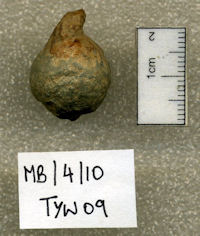
Plate 1: Musket ball with possible imbedded iron nail
The archaeological signature of battlefields, and other sites of conflict such as skirmish sites, sieges, encampments and training grounds, is often largely defined in the landscape as scatters of artefactual material suspended in the topsoil (Pollard 2009). Such scatters represent the debris of conflict; intensive volleys of bullets, weapons broken in hand-to-hand combat, fittings torn from clothing and items of personal value dropped or damaged. Detailed analysis of artefacts within the recovered assemblage is an important part of the interpretation process, for example the morphology of a musket ball may reveal valuable information ranging from the types of firearms used, to identifying practices such as modification of the projectile to inflict greater damage to the target (Plate 1). However, it is the spatial relationship between these artefacts that often holds the key to understanding the dynamics of how the conflict was fought, with the pattern of artefact distributions defining the nature and extent of the site in the landscape. Dense concentrations of material such as musket balls, pistol balls and fragments of weaponry indicate areas of close engagement, most likely occurring at the front line of attack. Equally, thin spreads and trails of material may identify areas of rout where an army has broken and fled across the battlefield. Gathering such evidence accurately is crucial in forming an understanding of the conflict, because, as short-lived events, lasting only hours if not minutes, they may only remain as faint archaeological footprints sensitive to disturbances such as topsoil removal or the unrecorded recovery of artefacts.
An interesting illustration of how well these spatial relationships may be preserved in the ploughsoil and the importance of recording them accurately may be found in an artefact scatter of battle-related material recorded by metal detectorist Jon Pettet on the battlefield of Sedgemoor (1685) in Somerset (Fig. 1). The Battle of Sedgemoor was a short-lived rebellion led by the Duke of Monmouth, the illegitimate son of Charles II, against his uncle James II, who had recently ascended the throne. Monmouth gathered an army of peasants and artisans; no match for a well-trained and seasoned Royalist army. In an area north of the Chedzoy New Cut, Pettet recorded a large volume of canister shot—musket balls contained within a canister and fired from a cannon. Not only were the projectiles themselves significant, representing rare examples that had fused together under the intense pressure and heat built up in the barrel during firing (Birkbeck pers. comm. 2008), but as their spread had been accurately recorded and plotted it was possible to identify where the Royalist artillery had been located on the battlefield and the direction of fire. Furthermore, the positioning of this spread directly corresponded to another scatter of canister shot recorded during a developer-led archaeological evaluation of the battlefield in advance of the construction of a sewerage pipeline (Foard 2009a, 10). This evidence suggests that the Royalist artillery had been moved north towards the Rebel line during the latter stages of the battle, possibly to break stubborn blocks of Rebel infantry that had resisted earlier cavalry attacks (Ferguson 2011).
The significance of artefact distributions and their movement in the ploughsoil are now better understood, as represented in the publication of heritage policy documents by English Heritage, including Managing Lithic Scatters (Schofield 2000, 5) and 'Our Portable Past' (English Heritage 2006, 2). Statutory protection may, in rare circumstances, be afforded to lithic scatters if considered to be of archaeological interest. Battlefields, on the other hand, cannot at the present time be offered legal protection under the Ancient Monuments and Archaeological Areas Act, 1979. They can, however, be highlighted within the planning process as sites of national importance if featured within either the English Heritage Battlefield Register (2012), the Historic Scotland Inventory of Battlefields (2012) or the forthcoming Welsh and Irish registers. The registers provide a solid platform with which to promote battlefields as nationally significant heritage and to raise awareness of the threats to its underlying archaeology. This raises the question of whether it is appropriate to allow hobbyist metal detecting on registered battlefields, a question which has featured frequently within recent debates regarding the future scope of the registers.
Internet Archaeology is an open access journal based in the Department of Archaeology, University of York. Except where otherwise noted, content from this work may be used under the terms of the Creative Commons Attribution 3.0 (CC BY) Unported licence, which permits unrestricted use, distribution, and reproduction in any medium, provided that attribution to the author(s), the title of the work, the Internet Archaeology journal and the relevant URL/DOI are given.
Terms and Conditions | Legal Statements | Privacy Policy | Cookies Policy | Citing Internet Archaeology
Internet Archaeology content is preserved for the long term with the Archaeology Data Service. Help sustain and support open access publication by donating to our Open Access Archaeology Fund.
File last updated: Thu Feb 28 2013